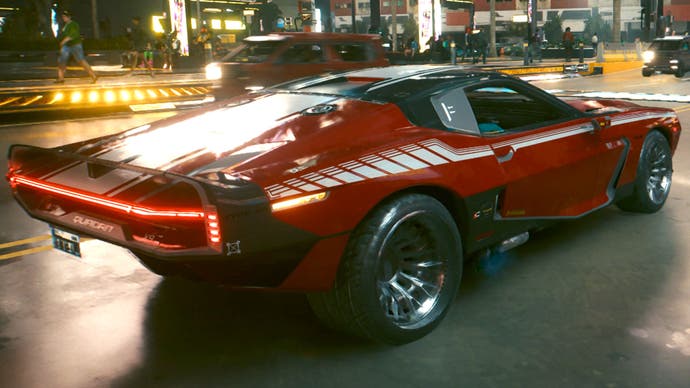How we ran Cyberpunk 2077 RT Overdrive on an entry-level RTX 3050
A new mod opens up a wealth of opportunities for all RTX owners - and RDNA can join in too.
The release of Cyberpunk 2077's RT Overdrive upgrade sees a new level of visual fidelity brought to a modern triple-A game via path tracing - the purest form of ray tracing. However, the perception is that only RTX 40-series GPUs or best-of-the-best 30-series cards get to run these visuals, but what if I was to tell you it's easily possible to get a 1080p, 30 frames per second experience on the RTX 3050 - Nvidia's entry-level RT-capable desktop graphics card? It can be done - and this opens the door to all of the 20-series and 30-series cards I tested handing in a surprisingly good experience. Not only that, but higher-end AMD RDNA 2 and RDNA 3 graphics hardware is in the mix too.
I first got the idea of doing some kind of performance piece on RT Overdrive when I added some benchmarks to the RTX 4070 review. The 4070 with frame generation is capable of running the game in excess of 60 frames per second using a combination of DLSS 2 balanced mode and DLSS 3 frame generation - and it looks pretty good. We're already in playable frame-rate territory for the RTX 3080, but the 3070 is struggling. We have options though - reducing resolution, reducing DLSS quality level - but most intriguing of all, a mod has recently appeared that increases performance by anything from 20 to 35 percent in my testing. Right now, Intel is off the table unfortunately, likely down to driver issues, but Arc has great RT hardware and surely it's only a matter of time before these GPUs join the fray.
The mod is available here on Nexus Mods, created by Erok and Scorn, and I found that the extra performance it delivers combined with reasonable quality settings for the GPU you have makes the difference between an experience that bottoms out in the low 20fps area, to one that should consistently keep you above 30fps. From there, run either unlocked or use the game's in-built 30fps v-sync cap. A consistent frame-rate always looks good, but I have to caution you that the lag this introduces in Cyberpunk 2077 is pretty awful. Either way, I was highly surprised at how good the experience was. The mod mention 'almost free FPS', but there's no such thing as a free lunch when it comes to rendering, so what does it actually do?
Essentially, ray tracing is about literally tracing the path of light and its bounces against geometry. At stock settings, the game simulates two bounces of indirect lighting and this is reduced to one bounce with the mod. The most obvious degradation to fidelity comes from reflections. Lighting visible on objects in the reflection is completely missing bounce lighting as the secondary bounce is no longer there. Objects in the reflection can look nearly black - excluding those areas that are directly lit by the sun or by local lights. Obviously this is a noticeable step back in terms of visual realism.
For diffuse lighting that's readily seen everywhere in the game world, the impact here is that every area is now technically darker and indirectly lit areas are darker still, while the reduction light means that the game's post-processing changes:,less light enters the virtual camera, so eye adaptation becomes more extreme. It's a quality downgrade then, but the lion's share of the impact of the path-traced presentation remains intact. There's also precedent for this reduction in light bounces - Nvidia's own Portal RTX allows you to configure the amount of bounces in order to open up the game to more GPUs. I'd imagine that once RT Overdrive migrates from a technology preview to a full product, we'd see quality settings like this added to the game.
So, if you want to sample RT Overdrive on the RTX 3050, recommended settings are 1080p, DLSS performance mode. Switch that up to DLSS quality on 2070 Super, 2080 or RTX 3060. If you look at the benchmark table on this page, you can see a grouping of GPUs at the bottom, where the RTX 3050 sits almost at the foot, with only the RX 6800 XT worse off. I'd say that every card beneath the RTX 3070 threshold should be able to produce a decent 1080p30 experience - the further you up go, the better the reconstruction technique you can use. Even so, with the RX 6800 XT, I could still hit 30fps and use FSR2 balanced mode. It's not a fully consistent 30fps though, but you can judge the results for yourself by checking out the footage in the video.
Cyberpunk 2077 RT Overdrive, 1440p, Balanced Upscaling
The RTX 3070 threshold is interesting though because in theory, the RTX 2080 Ti should be as potent - but it is not. All 20-series cards underperform according to existing benchmarks. The 3070 trounces 2080 Ti, while even the 3060 beats out the 2080 by around 11 percent. Returning to RTX 3070 though, 1440p looks viable, but the 24fps minimum is onerous. However, Erok and Scorn's mod bumps the worst case to around 30fps, meaning that 1440p with DLSS balanced mode is viable. The increase in rendering resolution and reconstruction quality works wonders in improving image quality. The fuzz has been lifted and we're back to a level of fidelity that befits the hardware. This is the point where Cyberpunk 2077 RT Overdrive really delivers a fantastic visual return and the news only gets better once you take that same 1440p balanced setting over to an RTX 3080.
You're not at 60 frames per second locked with the mod, but you are usually within the VRR window, so you're getting a perceptually smoother experience. The truth is, when you start reaching 3080 level hardware, the unmodded experience is eminently playable at 1440p - the mod simply pares back RT in the ways I described earlier and gets you a good chunk of performance back.
The RTX 3080 is a great card and allows you to get some very, very striking results from RT Overdrive without the need to use the mod and reduce the quality level of the path tracing. I found that I could get some impressive results by using the Nvidia control panel to set up a custom 3200x1800 resolution. At this point, I can run RT Overdrive on DLSS performance mode, target 30fps and the vast majority of play hits the frame-rate target. The only exception to the rule came via a run through the cherry blossom marketplace near Tom's Diner, where frame-rate tanked. Overall though, this was a very pleasing presentation - though 1440p with the mod keeps you in the high 40s to beyond 60fps, so a good fit for G-Sync, FreeSync or VRR screens.
At this point, it would be remiss of me not to point out that you don't need a discrete GPU at all to get a 4K RT Overdrive experience - you can stream via the cloud via GeForce Now on its 4080 Tier. This is point blank the best streaming experience I've ever had. The servers are essentially running a pared-back version of the RTX 4090 silicon with 24 gigs of VRAM, delivering ballpark desktop 4080 performance backed by a 16-core Ryzen 5000 CPU. Typically, I'd say you're looking at 50-75fps frame-rates, though there are occasional dips into the 40s - and that's with frame generation active. I was impressed with input lag too, even with frame-gen in the picture. It's not as precise as a local experience, but headshots were doable.
In summary then, at launch CD Projekt RED was suggesting that RT Overdrive would only run on 40-series cards and best-of-the-best Ampere GPUs but the truth is that it'll run on any DirectX12 Ultimate class graphics hardware and with strategic settings management and the deployment of a mod, it's possible to experience path-tracing on any RTX card and a good selection of higher-end AMD offerings. It's true that 40-series performance and DLSS 3 frame generation combine to give massively improved returns - 4K really is something on RTX 4080 and RTX 4090 class hardware - but the tools are there to get the game running better than expected on current-gen GPUs.
What we've shown today may not be the greatest RT Overdrive experience you can get, or even the best way to play Cyberpunk 2077 on your PC, but a playable path-traced triple A game already borders on the implausible - and the idea it can run on even the cheapest RTX card only adds further to the general level of disbelief surrounding this release.









